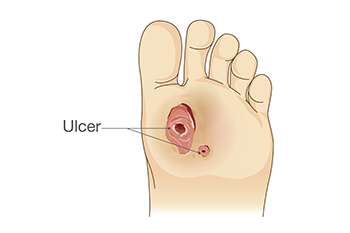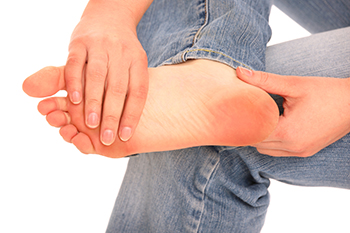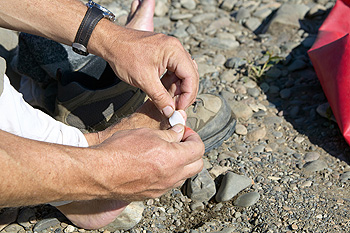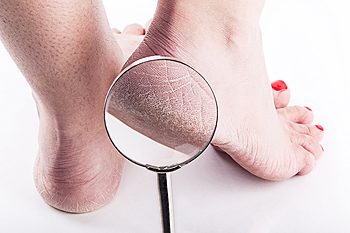Items filtered by date: July 2023
The Seriousness of a Diabetic Foot Ulcer

People who are diabetic are generally concerned about developing a diabetic foot ulcer. Proper wound care treatment is crucial for this type of infection, and serious consequences may ensue if prompt medical attention is not received. Research has shown that approximately 25 percent of diabetic patients will develop a foot ulcer, and implementing prevention techniques may help to avoid this. An essential step for this type of wound care treatment can be to remove the necrotic or dead wound tissue. This is referred to as debridement, and there are various ways to treat this. It is important to reduce any pressure on the wound, and often an off-loading boot is worn. The wound is typically drained, and the healthy underlying tissue is examined. Effective prevention methods can include keeping glucose levels within a normal range, drinking plenty of water daily, and eating healthy foods. If you have a diabetic foot ulcer, it is strongly suggested that you are under the care of a podiatrist who can provide the proper treatment.
Wound care is an important part in dealing with diabetes. If you have diabetes and a foot wound or would like more information about wound care for diabetics, consult with Dr. Kenneth Donovan from Advanced Care Foot and Ankle. Our doctor will assess your condition and provide you with quality foot and ankle treatment.
What Is Wound Care?
Wound care is the practice of taking proper care of a wound. This can range from the smallest to the largest of wounds. While everyone can benefit from proper wound care, it is much more important for diabetics. Diabetics often suffer from poor blood circulation which causes wounds to heal much slower than they would in a non-diabetic.
What Is the Importance of Wound Care?
While it may not seem apparent with small ulcers on the foot, for diabetics, any size ulcer can become infected. Diabetics often also suffer from neuropathy, or nerve loss. This means they might not even feel when they have an ulcer on their foot. If the wound becomes severely infected, amputation may be necessary. Therefore, it is of the upmost importance to properly care for any and all foot wounds.
How to Care for Wounds
The best way to care for foot wounds is to prevent them. For diabetics, this means daily inspections of the feet for any signs of abnormalities or ulcers. It is also recommended to see a podiatrist several times a year for a foot inspection. If you do have an ulcer, run the wound under water to clear dirt from the wound; then apply antibiotic ointment to the wound and cover with a bandage. Bandages should be changed daily and keeping pressure off the wound is smart. It is advised to see a podiatrist, who can keep an eye on it.
If you have any questions, please feel free to contact one of our offices located in Warren, Livingston, and Toms River, NJ . We offer the newest diagnostic and treatment technologies for all your foot care needs.
The Importance of Taking Foot Pain Seriously

Our feet are the foundation of our support and facilitate our mobility. While it is common to experience foot pain occasionally, dismissing or ignoring it can have serious consequences. Foot pain can stem from various causes, ranging from simple issues like ill-fitting footwear to underlying medical conditions that require immediate attention. Since such pain can arise from multiple factors, it is important to identify the source to differentiate between discomfort that may be temporary and signs of a more serious problem. Medical conditions, such as diabetes, with the common complication of neuropathy, or deep vein thrombosis involving blood clots can cause foot pain, and it is crucial to address these issues promptly. Age-related foot problems, such as arthritis, can cause chronic foot pain that requires care. Given the diverse causes of foot pain and the potential severity of complications, if you are having such pain, it is strongly suggested that you consult a podiatrist for an accurate diagnosis and suitable treatment.
Foot Pain
Foot pain can be extremely painful and debilitating. If you have a foot pain, consult with Dr. Kenneth Donovan from Advanced Care Foot and Ankle. Our doctor will assess your condition and provide you with quality foot and ankle treatment.
Causes
Foot pain is a very broad condition that could be caused by one or more ailments. The most common include:
- Bunions
- Hammertoes
- Plantar Fasciitis
- Bone Spurs
- Corns
- Tarsal Tunnel Syndrome
- Ingrown Toenails
- Arthritis (such as Gout, Rheumatoid, and Osteoarthritis)
- Flat Feet
- Injury (from stress fractures, broken toe, foot, ankle, Achilles tendon ruptures, and sprains)
- And more
Diagnosis
To figure out the cause of foot pain, podiatrists utilize several different methods. This can range from simple visual inspections and sensation tests to X-rays and MRI scans. Prior medical history, family medical history, and any recent physical traumatic events will all be taken into consideration for a proper diagnosis.
Treatment
Treatment depends upon the cause of the foot pain. Whether it is resting, staying off the foot, or having surgery; podiatrists have a number of treatment options available for foot pain.
If you have any questions, please feel free to contact one of our offices located in Warren, Livingston, and Toms River, NJ . We offer the newest diagnostic and treatment technologies for all your foot care needs.
Sore Feet While Hiking

Hiking can be a fun and challenging activity for nature lovers. It can be great exercise and provide one with the experience of stunning views and a huge sense of accomplishment. Most hikers have experienced some foot pain during a hike at some point in time. While blisters, plantar fasciitis, or hot spots can commonly befall hikers, other things like tendonitis can occur as well. Painful blisters are a common hiking problem. These are fluid-filled pockets that develop under the skin and are caused by friction. Blisters can easily come on from overuse and wearing boots that do not fit well. Plantar fasciitis is an inflammation of the plantar fascia, which is the connective tissue that runs from the heels to the toes on the underside of the foot. It can make every step a hiker takes painful, particularly in the heel and arch of the foot. A hot spot is a signal that a blister is about to form. Foot pain prevention measures to take before a hike include training for the hike by doing aerobic exercise, and resistance training. Also, practicing shorter hikes on similar terrain, wearing well-fitting hiking boots, using orthotic insoles, and wearing lightweight, breathable, and cushioned socks. When discomfort surfaces during a hike, stop to deal with it before it worsens. A foot care kit can be prepared beforehand and taken on hikes for this purpose. Simple things to include in such a kit are an extra pair of socks, athletic or duct tape, powder, and blister patches. If your foot pain from a hike persists or worsens, it is strongly suggested that you make an appointment with a podiatrist who can evaluate the problem and provide treatment options.
Ankle and foot injuries are common among athletes and in many sports. They can be caused by several problems and may be potentially serious. If you are feeling pain or think you were injured in a sporting event or when exercising, consult with Dr. Kenneth Donovan from Advanced Care Foot and Ankle. Our doctor will assess your condition and provide you with quality foot and ankle treatment.
Common Injuries
The most common injuries that occur in sporting activities include:
- Achilles Tendonitis
- Achilles Tendon Rupture
- Ankle Sprains
- Broken Foot
- Plantar Fasciitis
- Stress Fractures
- Turf Toe
Symptoms
Symptoms vary depending upon the injury and in some cases, there may be no symptoms at all. However, in most cases, some form of symptom is experienced. Pain, aching, burning, bruising, tenderness, tightness or stiffness, sensation loss, difficulty moving, and swelling are the most common symptoms.
Treatment
Just as symptoms vary depending upon the injury, so do treatment options. A common treatment method is known as the RICE method. This method involves rest, applying ice, compression and elevating the afflicted foot or ankle. If the injury appears to be more serious, surgery might be required, such as arthroscopic or reconstructive surgery. Lastly, rehabilitation or therapy might be needed to gain full functionality in the afflicted area. Any discomfort experienced by an athlete must be evaluated by a licensed, reputable medical professional.
If you have any questions, please feel free to contact one of our offices located in Warren, Livingston, and Toms River, NJ . We offer the newest diagnostic and treatment technologies for all your foot care needs.
A Lack of Vitamins May Cause Cracked Heels

Many people have the foot condition that is known as cracked heels. Various reasons, including vitamin deficiency, can cause this ailment. A lack of vitamin E can affect the skin and cause it to dry. Good sources of this vital nutrient can include sunflower seeds, salmon, avocado, and various oils. Additionally, patients who do not have adequate amounts of vitamin B-3 may develop a condition called pellagra. This can cause the skin to become dry and scaly, affecting the heels. Sources of this vitamin can consist of brown rice, lentils, poultry, and seafood. Existing medical conditions may also lead to developing cracked heels, such as eczema and athlete’s foot. Cracked heels can be prominent among people who frequently walk barefoot and may be prevented when sandals or shoes are worn. If you have cracked heels, it is suggested that you schedule an appointment with a podiatrist who can guide you toward the treatment routine that is correct for you.
Cracked heels are unsightly and can cause further damage to your shoes and feet. If you have any concerns, contact Dr. Kenneth Donovan from Advanced Care Foot and Ankle. Our doctor can provide the care you need to keep you pain-free and on your feet.
Cracked Heels
Cracked heels appear unappealing and can make it harder for you walk around in sandals. Aside from looking unpleasant, cracked heels can also tear stockings, socks, and wear out your shoes. There are several methods to help restore a cracked heel and prevent further damage.
How Do You Get Them?
Dry skin is the number one culprit in creating cracked heels. Many athletes, walkers, joggers, and even swimmers suffer from cracked heels. Age and skin oil production play a role to getting cracked heels as well.
Promote Healing
Over the counter medicines can help, especially for those that need instant relief or who suffer from chronic dry feet.
Wear Socks – Wearing socks with medicated creams helps lock in moisture.
Moisturizers – Applying both day and night will help alleviate dryness which causes cracking.
Pumice Stones – These exfoliate and remove dead skin, which allows for smoother moisturizer application and better absorption into the skin.
Change in Diet
Eating healthy with a well-balanced diet will give the skin a fresh and radiant look. Your body responds to the kinds of food you ingest. Omega-3 fatty acids and zinc supplements can also revitalize skin tissue.
Most importantly, seek professional help if unsure how to proceed in treating cracked heels. A podiatrist will help you with any questions or information needed.
If you have any questions, please feel free to contact one of our offices located in Warren, Livingston, and Toms River, NJ . We offer the newest diagnostic and treatment technologies for all your foot care needs.






